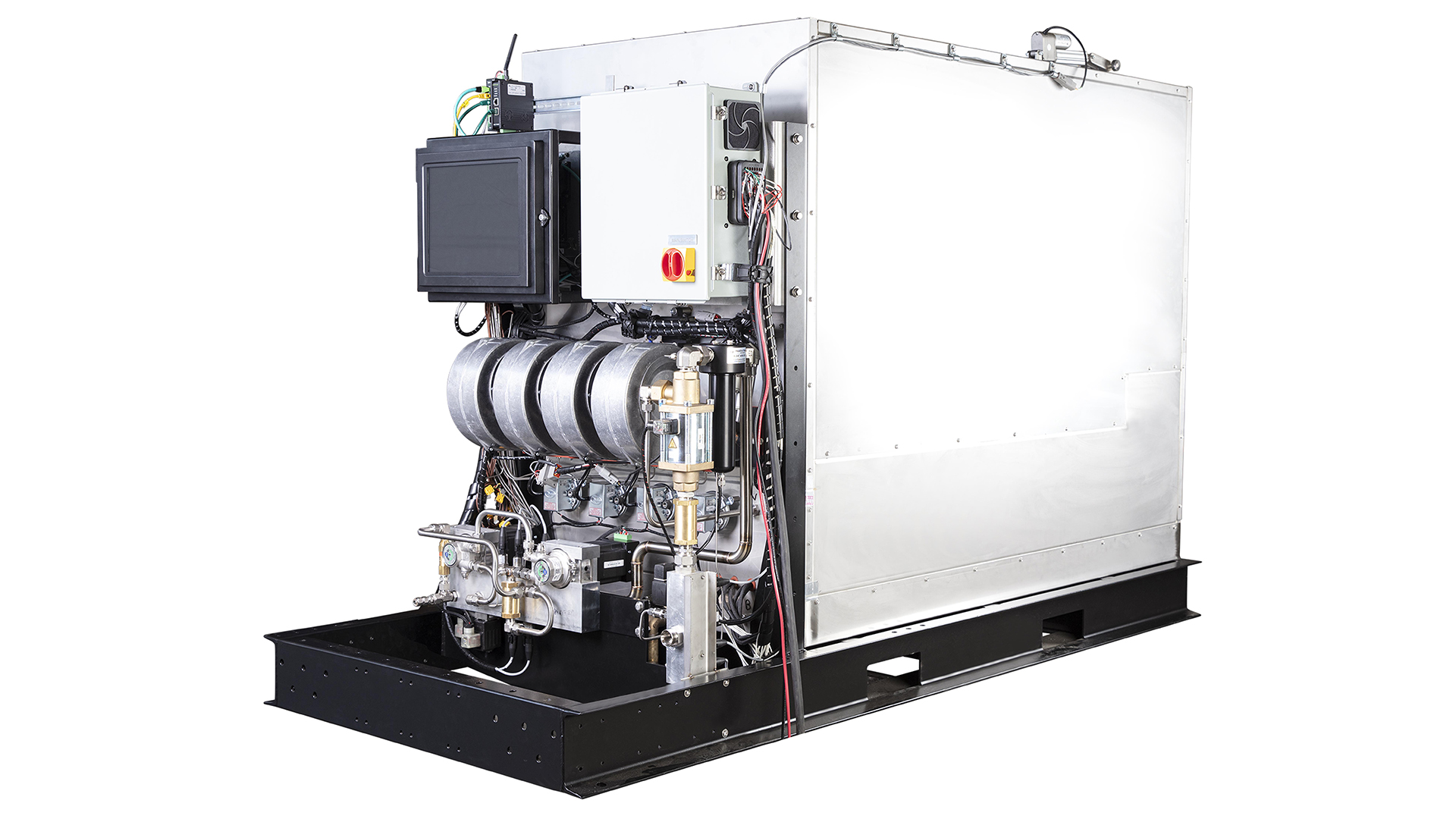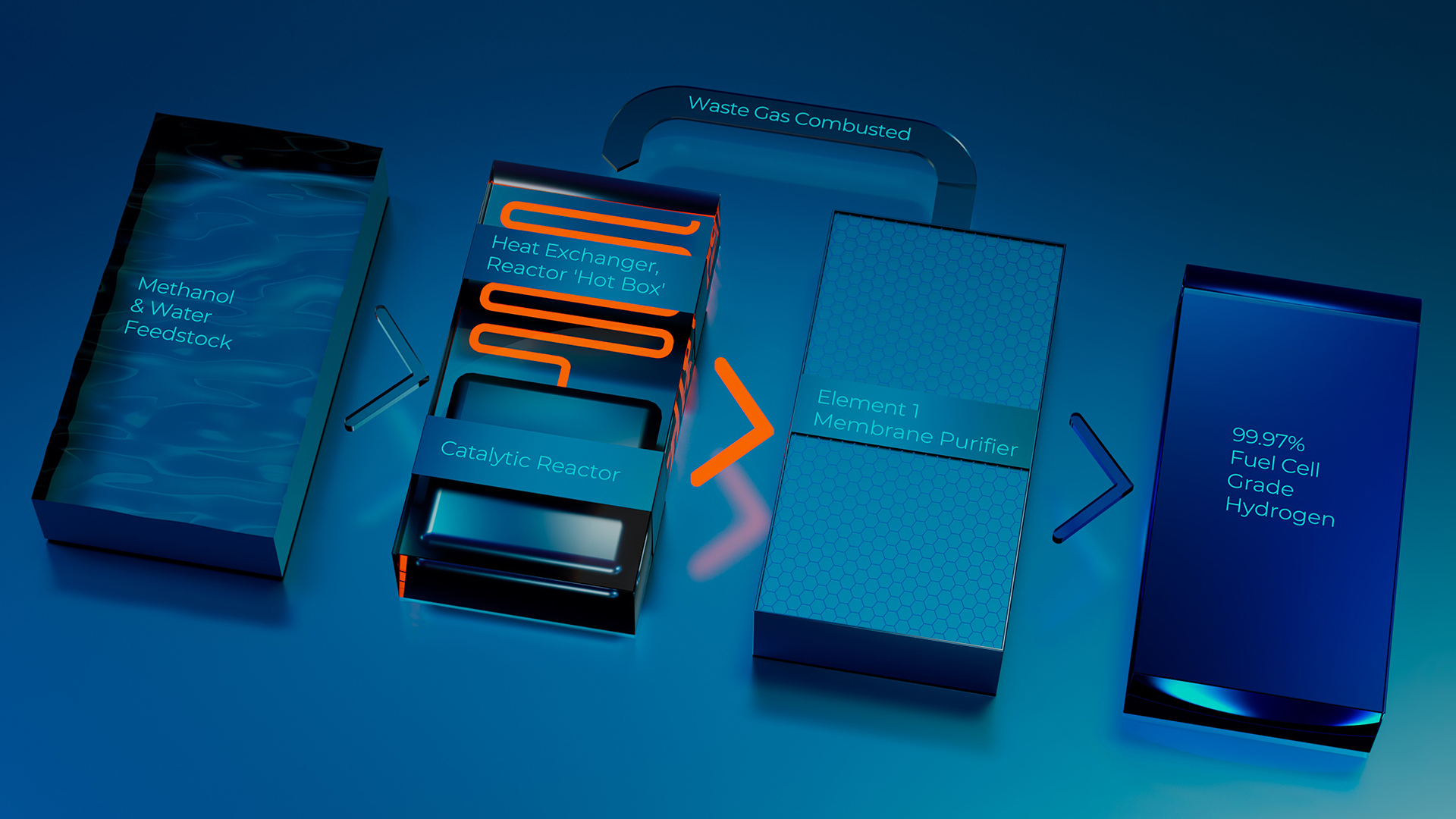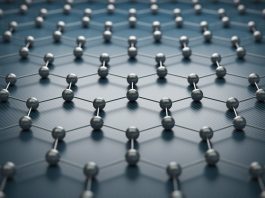As the world works towards a zero-carbon future, hydrogen is fast-becoming a popular fuel option. As a result, it is important to create accessible, affordable, clean, and efficient solutions to accelerate the global adoption of hydrogen fuel cell technology.
One company doing just that is Element 1. Founded in 2010, and based in Bend, Oregon, Element 1 is led by industry experts with unrivalled experience in hydrogen generation technology – and is positioned to provide game-changing technology solutions to the clean energy sector, including advanced hydrogen generation systems supporting the fuel cell industry.
To find out more about the company’s solutions and its goals to accelerate the global adoption of hydrogen fuel cell technologies, The Innovation Platform spoke to Dave Edlund, CEO of Element 1 Corp.
Can you start by briefly outlining Element 1 and its product offering?
Element 1 Corp is a technology development and licensing organisation (privately held) with deep expertise in chemical process development, hydrogen purification, and methanol-to-hydrogen generators.
Currently, we offer three product lines to our licensing partners. The S-Series is our small-scale hydrogen generator, designed to deliver up to 0.7kg of hydrogen per hour (17kg of hydrogen per day). The L-Series and M-Series are our largest hydrogen generators, scaled to deliver 9.8kg of hydrogen per hour or 235kg of hydrogen per day. In addition, the M-Series is specifically developed for installation onboard heavy-duty vehicles such as large trucks, trains, and maritime vessels, thereby enabling on-demand hydrogen generation to support vehicle propulsion without the requirement of storing liquid hydrogen or high-pressure compressed hydrogen on the vehicle or vessel.
When Element 1 enters into a license agreement, we provide all documentation (3D models, 2D prints, bill-of-materials, material specifications, quality procedures, a comprehensive list of vendors, tooling and special assembly fixtures, control code) and hands-on training to enable our partners to manufacture the hydrogen generators. This process (‘technology transfer’) involves approximately six months of collaborative effort and is conducted both at Element 1 and the license partner’s manufacturing location.
What is the range of Element 1 hydrogen generator products? How do they work and what is the resulting cost of hydrogen?
Although very different in scale, the S/L/M-Series hydrogen generators all function in a similar fashion. A mixture of methanol and water (the feedstock) is pumped into the hydrogen generator under pressure of approximately 15-20 bar. The feedstock is then vaporised before flowing through a catalytic reactor at about 400°C, causing the methanol and water to chemically react, generating a product gas mixture that is primarily hydrogen with smaller amounts of carbon monoxide, carbon dioxide, and water vapour. A proprietary hydrogen purifier then separates a stream of high-purity hydrogen from this gas mixture and the waste stream, or by-product gases, are burned to heat the vaporisers and reactors. This process, and the design of the components, are protected by more than 30 issued patents in multiple countries, as well as trade secrets.
This thermochemical process is very efficient, routinely demonstrating up to 84% energy efficiency, while using very little electricity. Even our largest hydrogen generators (M18 and L18 models) consume less than 1 kW of electrical power when producing 235kg hydrogen per day, or about 0.1 kilowatt hours (kWh) per 1kg of hydrogen. In comparison, water electrolysers require more than 50 kWh of electrical power to generate 1kg of hydrogen. That is 500 times more electrical energy than the Element 1 hydrogen generator consumes.

All our hydrogen generators operate under fully automated control, which can be slaved to a master controller using controller area network (CAN) communication protocol. Integration with a fuel cell module, a hydrogen combustion engine, or a hydrogen compressor is straight forward using a small, low-pressure hydrogen buffer tank placed between the hydrogen generator and whatever appliance is consuming the hydrogen. The hydrogen generator simply operates to maintain pressure in the buffer tank between minimum and maximum limits (software inputs).
The cost of producing purified hydrogen from methanol and water is largely dictated by the cost of methanol (the cost of water is insignificant). For example, if methanol is $400/metric ton (1,000kg), the cost of hydrogen is approximately $3/kg.
A noteworthy characteristic of our hydrogen generators is their small physical size relative to the rated hydrogen output. To illustrate this point, the M18 and L18 each are 879mm (W) x 2,080mm (L) x 1,380mm (H).
What applications are targeted using the hydrogen generator products? Why these applications?
The Element 1 hydrogen generators are designed for economical, on-site production of high-purity hydrogen. As such, they directly compete with compressed hydrogen (tube trailers or racks of cylinders), liquid hydrogen, and water electrolysers. Each of these competing options results in hydrogen that is three to five times more costly than hydrogen from methanol/water feedstock, in part due to the favourable economics of transporting methanol over distance relative to the cost of transporting either compressed hydrogen or liquid hydrogen.
Most of the commercial interest in our hydrogen generators is tied to electrified propulsion; on-road and off-road vehicles, aviation, and maritime. For example, the tow boat M/V Hydrogen One is being built using ten M18 hydrogen generators to provide hydrogen to ten 185-kW (nominal) fuel cells. M/V Hydrogen One is scheduled to be launched in late 2023 in the US gulf, and order interest for initially five additional sister tow boats is heating up. The maritime sector is expected to represent a large commercial opportunity, driven by international pressure to reduce not only carbon emissions, but also sulphur oxide (SOx), nitrogen oxide (NOx), and particulate emissions from engines burning diesel or marine oil.
Two other exciting applications are hydrogen fuelling stations and battery electric vehicle (BEV) charging stations. These two infrastructure plays represent enormous opportunity globally. In particular, grid-independent charging stations comprising one or multiple hydrogen generators paired with fuel cell modules (or hydrogen combustion engine coupled to a generator) promise to overcome the inherent shortcomings of regional or national electric grids.
As we have recently witnessed in the United States, the national grid is often operating at capacity, and small disruptions due to inclement weather or wildfires can result in massive and widespread power outages. This year, we saw both California and Oregon warn of scheduled blackouts to conserve electrical power during summer periods of higher-than-normal temperatures. As governments continue to advocate for the replacement of gasoline- and diesel-powered automobiles and commercial vehicles with battery-electric drive trains, the demand for electric power will increase substantially. Some estimates place the increased demand as high as 30% more than current grid capacity.
Rapid DC charging of battery electric vehicles represents an especially high demand for electrical power, above and beyond the capacity built into many national or regional grids. For example, charging a vehicle with 80 kWh in a period of 20 minutes requires a supply of 320 kW of power to the charging cable. Multiply this by the 500,000 new charging sites that the US plans to deploy, or the roughly two million charging sites that the EU expects to build, and one can see the magnitude of this challenge in terms of grid expansion, cost, and disruption to urban infrastructure.
A 400-kW grid-independent charging station incorporating Element 1’s L-Series product will have a footprint of approximately 10m x 3m, excluding above ground or below ground tankage for methanol. A further advantage of these grid-independent solutions is resiliency to failure of the regional or local electrical infrastructure.
What makes Element 1 different? What advantages do hydrogen generators have over water electrolysers?
The Element 1 technology allows for the deployment of hydrogen generators that are energy efficient, compact in size, and scalable with respect to hydrogen output, all while delivering high-purity hydrogen at a very attractive price per kg. In comparison, water electrolysers fall short on all these metrics. In particular, the energy efficiency of commercial water electrolysis (the process of using direct current electricity to split water into oxygen and hydrogen) is only about 66%, typically requiring more than 50 kWh of electricity to generate 1kg of hydrogen. Considering that fuel cells convert hydrogen into electricity with an energy efficiency of 45-55%, the overall process efficiency of water electrolysis plus fuel cell to yield electrical power is poor (about 30-36%).
The methanol-to-hydrogen generator produces hydrogen at 84% energy efficiency, so the overall energy efficiency using a fuel cell is about 38% to 46% – a marked improvement over water electrolysis.

But efficiency is only part of the story. Water electrolysis requires more than 9kg of high-purity water to yield 1kg of hydrogen. With potable water in limited supply in many parts of the world, and drought hitting portions of North America and Europe, supply of high-purity water for hydrogen production should be viewed as a risky and expensive proposition. Plus, there is the moral question of whether diverting water away from human consumption and agriculture for use in energy production is ethical. The Element 1 hydrogen generator does consume water in addition to methanol, however our specific requirement for water is less than half that needed by electrolysis to yield 1kg of hydrogen, and we can use water of lower purity.
What is the potential for ‘green’ hydrogen from methanol?
There are many reasons why methanol is perhaps nature’s perfect energy carrier: it is a non-corrosive liquid that is easily and economically transported globally; it is naturally biodegradable; and methanol is commercially manufactured from a wide range of starting materials. The latter leads directly to methanol potentially being a very ‘green’ precursor to hydrogen. So-called ‘renewable methanol’ is synthesised following two general, but different, chemical routes: one is biogenic in nature and the other is based on reacting hydrogen with carbon dioxide.
It is significant that methanol is readily synthesised from a gas stream comprised of hydrogen and carbon dioxide, with or without carbon monoxide (generically termed syngas). This is basic chemical engineering that has been the foundation of the global petrochemical industry for about 100 years. Syngas is readily derived from carbon-containing materials following reaction with water or oxygen (from air).
Renewable methanol made following the biogenic pathway will use syngas made from biomass, animal and human waste, and even garbage buried in landfills. Without human intervention, these waste materials will slowly and naturally decompose and release large quantities of carbon dioxide and methane – both greenhouse gases – into the environment. Indeed, methane has a global warming potential many times greater than carbon dioxide. By avoiding these harmful emissions, and converting the renewable feedstock into green methanol, the result is methanol with a low (even negative) carbon intensity.
To realise renewable methanol by combining hydrogen with carbon dioxide, it is imperative that the hydrogen is synthesised using renewable electricity such as wind or solar radiation. When made by this pathway, the renewable methanol is called e-methanol. Because of the favourable economics of transporting methanol over great distance versus hydrogen, e-methanol is viewed as a practical method of capturing remotely-generated green electricity, storing that energy, and then shipping it often hundreds to thousands of kilometres to the point of use.
The Methanol Institute is tracking more than 80 renewable methanol projects around the globe that are projected to produce more than eight million metric tons, or ten billion litres, of e-methanol and biogenic methanol by 2027.
Whether biogenic renewable methanol or e-methanol is the feedstock to make hydrogen, the resulting carbon intensity of the product hydrogen compares favourably with both the European sustainable hydrogen directive (less than 3kg CO2e/kg hydrogen) and the United States clean hydrogen mandate (less than 2kg CO2e/kg hydrogen) as shown in Fig. 1. The strongly negative carbon intensity associated with renewable methanol synthesised from animal manure and sewage solid waste is due to avoided methane emissions. It is worth noting that achieving negative carbon intensity will contribute to offsetting the carbon footprint of certain sectors that are more difficult to decarbonise, such as aviation.
Do you think the current hydrogen infrastructure is sufficient to meet the rising demand for cleaner fuels? Do any changes need to be made?
Hydrogen is easily available in most industrialised countries for manufacturing and as a chemical feedstock, but there is insufficient hydrogen to replace dirty fossil fuels. Without a doubt, the global hydrogen infrastructure requires massive investments if hydrogen is to play a significant role as a near-term source of green energy for transportation and stationary applications. Element 1 champions methanol-to-hydrogen generators as an affordable and practical way to build out the next generation of hydrogen infrastructure in small, easy to execute, and economically feasible steps.
The hub-and-spoke model of large, centralised hydrogen production requires distribution of hydrogen (either compressed or liquefied) over long distances to the point of use. This is an expensive proposition to be avoided. In the United States, the largest commercial trucks certified for highway operation are rated at 80,000 pounds gross vehicle weight and are called Class 8 trucks. A Class 8 truck hauling liquid methanol (the same type of tanker truck that hauls gasoline or diesel fuel) can generate as much hydrogen as would be transported in 21 Class 8 trucks carrying compressed hydrogen.
Although liquid hydrogen is more dense than compressed hydrogen, liquid methanol still contains 40% more hydrogen volumetrically than does liquid hydrogen. And liquefaction of hydrogen requires a significant amount of energy – equal to 30% of the heating value of the hydrogen – due to its exceptionally low boiling point (-253°C).
What is next for your business, your goals, and the direction of your products?
Element 1 is currently working to scale up the hydrogen output of our largest hydrogen generator by 40%, increasing the rated output to 325kg of hydrogen per day. We aim to achieve this milestone by the end of this year, but we do not intend to stop there. Based on customer pull, we expect to commence work in 2023 to achieve 500kg of hydrogen per day from a single M/L-Series hydrogen generator. This enhanced output has been requested for both maritime applications and hydrogen fuelling stations, and we expect it will also play a significant role in BEV charging stations.
As we continue to support our regional license partners with design advancements that include cost reduction and improved performance specifications, we will also continue our search for a global strategic partner to address the worldwide opportunities spanning many multi-billion-dollar verticals. Whether the application involves fuel cells, hydrogen combustion engines, or merely industrial use of hydrogen, the need for on-demand, point of use, economical hydrogen generation has never been greater.
Please note, this article will also appear in the twelfth edition of our quarterly publication.









